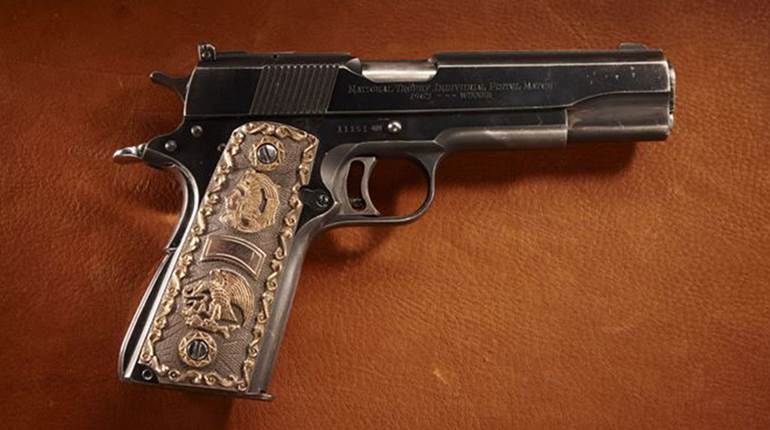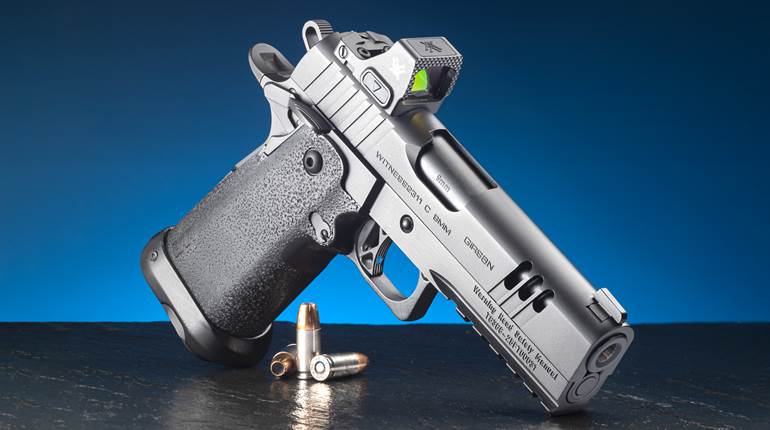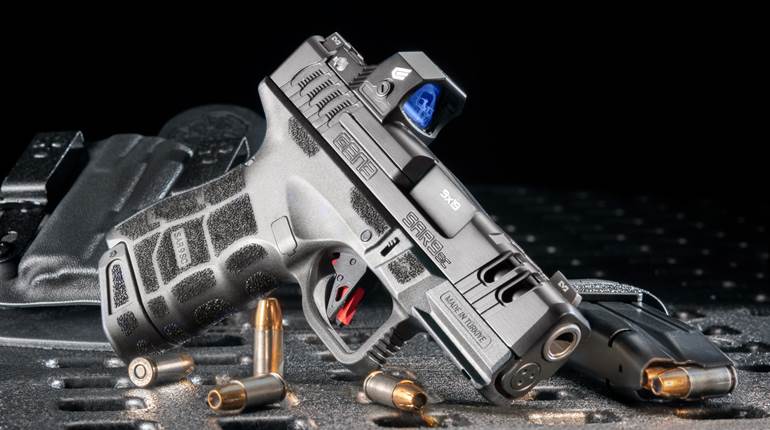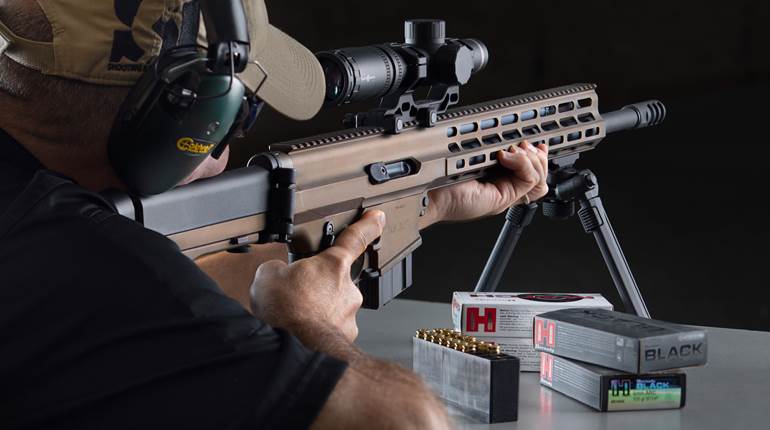
At one time, the National Rifle Association really didn’t like the M1 Garand. Shocking, right? This is certainly no longer the case, and I’ll give you a little proof. Back in 2008, we did an article called the “Top 10 Infantry Rifles” of all time. This “Top 10” concept was popular then and now. My staff voted overwhelming for the M1 Garand as the “best infantry rifle of all time.”
John Cantius Garand appeared on the cover of American Rifleman twice, once when his rifle was adopted and again after he retired and received M1 Rifle Serial No. 1,000,000.

I would call John C. Garand a great man, even though he never thought of himself as such. If it were not for him, the defeat of Nazi Germany and Imperial Japan would have cost many more American lives. Simply put, the G.I.s and Marines armed with the “U.S Rifle, Caliber .30, M1” did nothing less than save the world from unspeakable evil.

Today, I happily report that the M1 Garand has been on the cover of The American Rifleman more than any other firearm in our entire history. It appeared on the cover when it was first introduced, then again during the war years, then again in rifle competitions. We showed it again with John Garand in his retirement, then again during our coverage of Springfield Armory, again as a go-to collector’s rifle and in multiple instances as a standout piece of history, such as Scott Duff’s article on British Lend-Lease M1 Garands.

So, is it really true that, at one time, American Rifleman editors and the National Rifle Association harshly criticized and had little faith in “greatest battle implement ever devised?” Absolutely, and the story has roots in the development and early years of the rifle itself.
There was a time that John C. Garand was able to say nothing about his rifle, and that started the rift between NRA and the U.S. Army. Back in the mid-1930s, the man at the helm of The American Rifleman was Lawrence Hathaway. Our publication had reported on the U.S. Army Ordnance Department’s evaluations of semi-automatic rifles long before the magazine was even called The American Rifleman, which came about in 1916 after being sold to NRA by James A. Drain for $1.

In those days, editors and contributors went into incredible detail describing the guns and how they worked for our members. They covered novel designs like the Bang rifle, the Liu rifle, the Mondragon, the Winchester and Remington recoil-operated guns. Army Ordnance and NRA editors were on the same page.
They tested and reported on all these interesting guns for NRA members and the riflemen of the world. All these people had the right to know about these new designs, and the world was curious. Everyone knew that the semi-automatic infantry rifle was the next big thing. The U.S. Army had been looking at every feasible design since 1900.

Despite the veneration of the U.S. Rifle Model of 1903, the “Cult of the Springfield” I’ll call it—and the U.S. Marine Corps stayed in the cult longer than most—this was the most important stories in rifle development for at least 50 years. Once French chemist Paul Vielle Introduced Poudre B to the world in 1886, it was only a matter of time. A semi-automatic infantry rifle was going to happen for the U.S. Army. But what rifle would they pick, and when would it happen?
At this time, the U.S. Army Ordnance Department and American Rifleman editors were joined at the hip. They were in this together. NRA’s founding mission is about marksmanship and the national defense, after all. We reported on the primer-actuated rifle designed by a young, Canadian-born inventor by the name of Garand back in 1919. The Army gave NRA full access to the rifle and the story. Why? Because they weren’t going to adopt it. That inventor eventually got hired to work at the U.S. Springfield Armory.

The U.S. Army had been working on a semi-automatic rifle since before the turn of the 20th century. All of their efforts in testing the Bang and the Liu and every other crazy rifle that every crackpot in the world came up with had been reported in the pages of The American Rifleman. So began the journey to develop a semi-automatic infantry rifle for the U.S. Army.
The Ordnance Department hired the best commercial gun designer available, John D. Pedersen, to work on the concept. Pedersen, a contemporary of John Moses Browning and John Garand, was very good, indeed. Army Ordnance put them on separate design tracks and pitted all these great men against each other. But in the words of the 1980s Movie, “Highlander,” there can only be one. That one was the “U.S. Semiautomatic Rifle, Caliber, 30 M1.”

Really, the United States was the only country in the world that was capable of developing and mass-producing the M1 rifle. It was a country that had the willpower and the patience to develop the M1. The American Rifleman reported on it. This was big news. The biggest news.
But when we look at the first article about the M1 rifle, there are some clues as to the emerging rift. The author, Col. Drewry, was not on the magazine staff. He didn’t test guns for NRA members. He was an Army Ordnance officer.

How did this happen? Well, the story was not written for The American Rifleman. It was written for the Infantry Journal. The American Rifleman was merely allowed to run it. It must have chapped Editor Hathaway’s bunions to no end.
Back then, the most comprehensive evaluations of firearms in the world happened in the pages of The American Rifleman. If you made a gun, you sent us a gun. We shoot it, we tear it down, we describe every bit and piece, how it’s made and how it performs. We shoot it, and the gun does what it does.
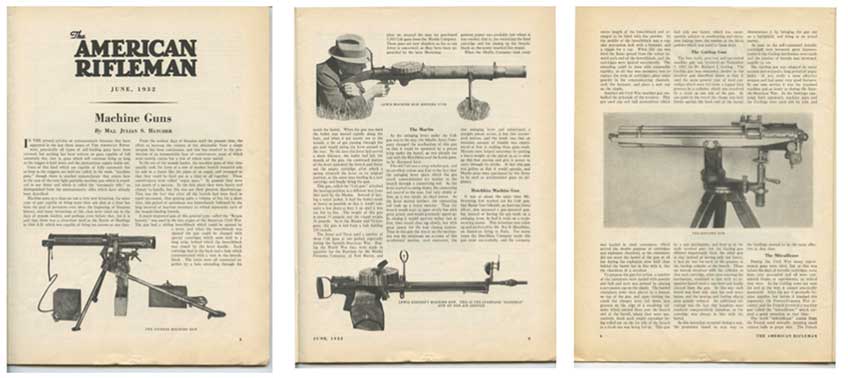
But in this instance, the Army wasn't talking. Fred C. Ness, American Rifleman technical editor, did not receive a “U.S. Semiautomatic Rifle, Caliber .30,” at the Barr Building or later at 1600 Rhode Island Avenue. They didn't let him take it apart and describe every feature. They didn't even brief him about it. The American Rifleman got the Army official story from Col. Drewry.
Meanwhile, there was a man named Julian S. Hatcher. He graduated from the U.S. Naval Academy and was commissioned as a lieutenant in the U.S. Army Ordnance Corps. He started contributing to The American Rifleman early and often. He answered questions from NRA members, he described guns, ballistics, loads and bullet performance. Again, Army Ordnance and The American Rifleman were joined at the hip through Hatcher.

Once the US Army adopted the U.S. Semiautomatic Rifle, Caliber .30 M1, in 1936, though, that all changed. Then-Major Julian S. Hatcher went silent. His brother, Major James Hatcher, was running the M1 rifle’s development. Julian Hatcher, who would later become technical editor of The American Rifleman, answered question about knockdown power and cast bullets, but not about the M1 rifle. In the pages of the magazine, as far as the M1 was concerned, Julian Hatcher went dark.
Hatcher was the one guy who regularly answered member letters in the pages of The American Rifleman, and he worked with John C. Garand in the 1920s. He would go on to write the Book of the Garand. He and Garand were friends. They shot in the Springfield Armory weekly pistol league together. Hatcher’s Colt Camp Perry is in the NRA Museum. I have a Christmas card from Major and Mrs. Julian Hatcher to Mr. and Mrs. John C. Garand. They were friends and worked together toward, arguably, the most-important American rifle of all time.

From 1935 to 1939, I know for a fact that Hatcher’s name appeared 158 times in 94 different NRA documents and publications. After the adoption of the M1, not a word written by him was about the M1.
The M1 Garand was adopted officially in 1936, and there is scant information about the rifle in the pages of the magazine. Snippets, but nothing substantive. It must have been incredibly hard on the editors, who were itching to understand and share this revolutionary new rifle design with NRA members.
Later, Camp Perry was blessed with a demonstration of the M1 rifle. Army Ordnance brought it, it shot, but not very well, and ordnance officials would not let NRA’s representative fieldstrip the rifle. They wouldn’t let our technical staff look inside the rifle. Even though that’s what The American Rifleman staff did and that’s what they had worked hand-in-hand with Army Ordnance on for decades at this point, the Army stopped them from taking a peek anyway.

The Army Ordnance Department’s secretiveness and their unwillingness to pull the trigger guard down and let NRA see inside the M1 led to congressional hearings, sensationalist national news stories and a feeling that the Army was hiding something about its new rifle. The Army’s reticence to share information about the M1 opened a door. A door that Melvin Maynard Johnson drove a truck through.
While development of the Garand had occurred, Johnson had worked on a separate rifle design. When the U.S. Army hid the M1 Garand from the NRA, Johnson was open and forthright about his new gun. Ness made Johnson and his rifle a national news story. His rifle had some features the M1 did not, being able to top off a magazine and a 10-round magazine capacity, for example. Since the Army hadn’t adopted his rifle, Johnson could let NRA take it apart and describe every piece.

The Army and NRA were in pretty much open conflict about the M1, and there were snarky reports throughout this period that illustrate this war of words. U.S. Army Ordnance even went so far as to run advertisements discussing the Army’s new M1 rifle in other magazines of the period, but not The American Rifleman.
Then came Camp Perry. At the Small Arms Firing School at Camp Perry that year, the Army once again demonstrated the M1 rifle. Attendees were allowed to fire the rifle, but NRA staff was prohibited from taking the gun apart. Ever heard of waving a red flag at a bull?

The flame stoked by the Army’s lack of cooperation led to a lot of public debate. It led to editorials from newspapers that couldn't tell an M1 rifle from a badminton racket. It led to congressional hearings, hearings in which senators and congressmen made the Army a little uncomfortable.
Meanwhile, NRA’s promotion of the Johnson rifle no doubt helped it go from prototype to production to limited service with the United States Marine Corps. If you ever want to find fans of Melvin Maynard Johnson designs, look no further than the “Super Commandos”—the Canadian and American troops that formed the U.S. Special Service Force. The “black devils” loved their “Johnny guns.”
It’s true that the Johnson rifle did have some good points, but F.C. Ness highlighted it more than was probably necessary, which only goes to show that there was a deeper purpose to the whole thing. In one article, Ness spent six pages describing the Johnson rifle in prototype form.

For contrast, another new gun appeared in 1936 that some might recognize: the Winchester Model 70. Yes, the “Rifleman’s Rifle.” The American Rifleman editors devoted far less space to this iconic design than they gave to the Johnson rifle.
Meanwhile, the Army still would not let NRA see inside an M1. The Army knew it had a problem with the gas trap, but it wasn’t going to admit it to anyone and certainly not to the NRA. There was a reason for that that extended beyond Ordnance department pride. From 1936 to 1940, the M1 was not perfect. It was not the gun that would win World War II.
In 1940, the Army decided to switch from the gas trap to the gas port and, in November of that year, made a change it didn’t talk about. That change was the drilling of a hole in the barrel and the elimination the unreliable gas trap. The gas-trap system worked better than most full-power semi-automatic military rifles, but it didn't work well enough.

It’s important to recognize that, in 1940, it was a very different world. No Army anywhere had a adopted a semi-automatic design as its standard service rifle, The French, the Soviets, the Germans and even the British had experimented. Some even adopted them but never for general issue.
All the secretiveness and lack of cooperation made it look as if the Army was hiding something about the M1 rifle. As it turns out, the Army was, and there were problems beyond the gas-trap issue. As the prototype rifles turned into production rifles, things begin to vex engineers at Springfield Armory.
The best known of these issues is the seventh-round stoppage. As most folks know, you can stick an M1 en-bloc clip in either way. Ordnance engineers found that if the top cartridge was on the right, then the seventh cartridge would also be on the right. This round would jump up out of position and jam the bullet nose into the receiver.

At the 1939 National matches at Camp Perry, Lt. Col. James L. Hatcher was doing a demonstration with the M1 Garand. The seventh-round stoppage hadn't been solved yet, so he and Capt. Rothwell Brown made sure that all the clips were loaded with a seventh round on the left. The demonstration went well, but as Julian S. Hatcher wrote in the Book of the Garand, “a feeling arose that all is not well.”
Hatcher continued: "At the demonstrations at Camp Perry, civilians were invited to fire the rifle, but there's always an Army man at the shooter’s elbow ready to snatch the rifle away and perform some sleight of hand at the slightest sign of a malfunction … . Moreover, the members of the NRA staff, to their surprise, found that they were unwelcome whenever they approached a Garand or wanted to fire it."

There were other issues. The jumping clip, the sticking operating rod cam, rear sight trouble, and of course, the M1 needed a new gas cylinder. By October 1939, the so-called gas port gas cylinder assembly, with a hole in the barrel, was recommended and adopted. Gas-port rifles started production early in 1940.
In May 1940, F.C. Ness of The American Rifleman obtained an M1 rifle and a single eight-round en-bloc clip. As a gun writer for the past 29 years, I know when a writer is out to get a gun. And F.C. Ness was out to get the M1 rifle. But the rifle he received was not the new gas-port M1 Garand. It was the older “gas-trap” gun that clearly had issues.

What's interesting is that, while reporting every stoppage, including those that occurred when single-loading, and criticizing the design, he did note that this was not the new “gas-port” system. Ness knew about the coming gas-port system that would make the M1 Garand into the reliable battle arm everyone knows today, but he chose to concentrate on the faults of the “gas-trap” Garand.
There's another aspect to all this that we can recognize today. It’s reasonable to assume that the Germans read The American Rifleman magazine at the time. If I had been a potential enemy of the United States, I sure would have, knowing how much information about U.S. Army Ordnance testing ended up in the pages of the magazine.
What if supplying F.C. Ness with a gas-trap model in February 1940 was the plan? What if the Army knew of Germany’s interest in the M1 rifle? What if they deliberately planted misinformation by giving F.C. Ness a gas-trap gun after the Army had already switched over to gas-port Garands?

Another interesting piece of information was the reporting of the number of M1 rifles being produced. In May 1940, it is said there are fewer than 25,000 guns. Only about 4,000 a month were reported.
No one involved is still alive, but this looks to me like the Army was trying to tell the Germans that the M1 wasn't ready for prime time in terms of the effectiveness of the rifle or the numbers produced. This is all pure speculation on my part, though still worth thinking about.
What is in the record is what Julian Hatcher thought about the secretive nature of the M1 rifle’s development and what possibly could have happened:
“Had the association been kept fully and frankly informed about the rifle, they could have been counted on by the War Department both for informed and constructive criticism and suggestions, and also for powerful support of any decisions reached as a result of Army needs and experience."

NRA’s leadership was comprised mostly of Army and National Guard officers. These were officers like Gen. Milton A Reckord, Adjutant General of the Maryland National Guard—who would eventually command the 29th Infantry Division during World War II. Think you could trust him? I do.
But as it stands, the first army in the world to declare a semi-automatic rifle as its standard-issue arm was the United States Army, and the M1 rifle became of the greatest military secrets of the age. How did America do it? Well, Nazi Germany wanted to find out.
The secret of the M1 Garand certainly wasn’t on the level of the later Manhattan Project, but our enemies still wanted all the information they could get. German spies sought out the plans to the M1 rifle. Members of the Duquesne Spy Ring actually obtained the plans for the M1—the FBI even filmed one Nazi spy pulling the schematics out of his sock in New York before the United States ever entered World War II.

Even though these Nazi spies were arrested, I think it is logical to assume Nazi Germany got the plans to the M1 Garand. After all, they found the plans for the Norden Bombsight. But the designs they obtained were not of the M1 Garand as we know it, the Garand that entered the battlefield in huge numbers during WWII. I believe they got plans to the gas-trap variant.
In late 1940, the German Ordnance Department solicited a semi-automatic rifle from Walther and Mauser for adoption in 1941. One of the requirements was that they could not drill a hole in the barrel. Why would they include such a specific requirement? I would argue that they may have had plans for the M1 rifle that did not have hole in the barrel. Both the Mauser G41(M) and the Walther G41(W) had goofy forms of gas-trap operation. Neither worked very well.

Early M1 Garands may have gotten into German intelligence hands from their Japanese allies following the fall of the Philippines, but the guns captured there would have been a mix of gas-trap and gas-port rifles. The Germans eventually drilled a hole in the barrel and came up with G43 rifle. The Japanese also copied the gas-port M1, and they came up with the Type 5.
Before the capture of these issued M1 Garands in the Philippines, the one thing that German ordnance seemed pretty serious about was that neither entrant, Walther or Mauser, was to drill a hole in the barrel. What they ended up getting was the G41(W) and the G41(M). Both rifles were frail and finicky, but neither of them had a hole in the barrel.

At that time, as far as the world knew, the U.S. Rifle, Caliber .30 M1 didn't have a hole in the barrel. The only scant mention of a gas-port model was in Ness’ May 1940 article in The American Rifleman. The only country in the world that ever figured out a reliable semi-automatic rifle concept was the United States. When the Germans went to develop their own, it is my supposition that they went with what they knew worked. That was the M1 Garand.
By the time that specification went out in 1940, there were no M1 rifles outside of the U.S. government. Sure, some were sent to England under the Lend-Lease Act. Some were sent to the Philippines. As a matter fact, the M1 rifle's introduction to combat came during the fighting for the Philippines in 1942. Despite being mostly gas-trap rifles, from everything we can tell, the M1 performed pretty well.

With improvements, though, the M1 rifle would perform even better. It would go on to be the rifle in the hands of young men who went overseas, fought and died so that the flame of freedom would not be extinguished. The rifle that went to North Africa, the rifle that went to Guadalcanal, to Monte Cassino, to Omaha beach, to Tarawa and Iwo Jima, wasn't the same rifle that the Germans tried to copy. It was not the same rifle that the army hid from the NRA. It was better.
In the interim, NRA got over its concerns about the M1 rifle. After Dec. 7, 1941, the NRA was all-in following the “day that will live in infamy.” NRA and its members went on to train millions of young Americans in marksmanship during pre-induction training programs.

We wrote manuals on marksmanship. We even did a “how-to” guide for plant and industrial guards. Our members served both at home and overseas. A generation of young Americans armed with M1 Garands did nothing less than save the world—one eight-round en bloc clip at a time.












